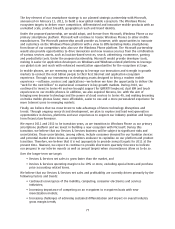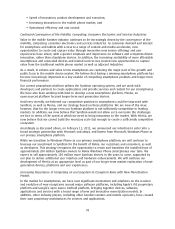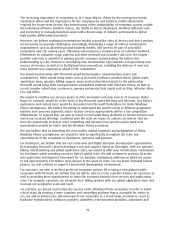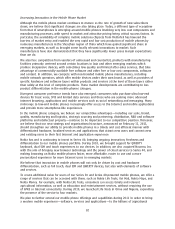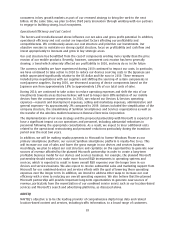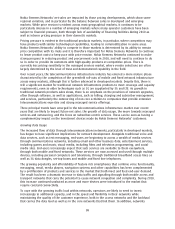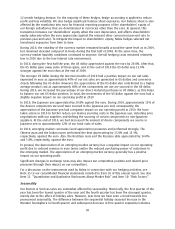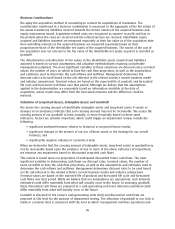Nokia 2010 Annual Report Download - page 87
Download and view the complete annual report
Please find page 87 of the 2010 Nokia annual report below. You can navigate through the pages in the report by either clicking on the pages listed below, or by using the keyword search tool below to find specific information within the annual report.Nokia Siemens Networks’ net sales are impacted by those pricing developments, which show some
regional variation, and in particular by the balance between sales in developed and emerging
markets. While price erosion is evident across most geographical markets, it continues to be
particularly intense in a number of emerging markets where many operator customers have been
subject to financial pressure, both through lack of availability of financing facilities during 2010 as
well as intense pricing pressure in their domestic markets.
Pricing pressure is evident in the traditional products markets, in particular, where competitors may
have products with similar technological capabilities, leading to commoditization in some areas.
Nokia Siemens Networks’ ability to compete in those markets is determined by its ability to remain
price competitive with its rivals and it is therefore important for Nokia Siemens Networks to continue
to lower product costs to keep pace with price erosion. Nokia Siemens Networks continued to make
strong progress in reducing product and procurement costs in 2010, and will need to continue to do
so in order to provide its customers with highquality products at competitive prices. There is
currently less pricing sensitivity in the managed services market, where vendor selections are often
largely determined by the level of trust and demonstrated capability in the field.
Over recent years, the telecommunications infrastructure industry has entered a more mature phase
characterized by the completion of the greenfield rollouts of mobile and fixed network infrastructure
across many markets, although this is further advanced in developed markets. Despite this, there is
still a significant market for traditional network infrastructure products to meet coverage and capacity
requirements, even as older technologies such as 2G are supplanted by 3G and LTE. As growth in
traditional network products sales slows, there is an emphasis on the provision of network upgrades,
often through software, as well as applications, such as billing, charging and subscriber management,
and services, particularly the outsourcing of noncore activities to companies that provide extensive
telecommunications expertise and strong managed service offerings.
Three principal trends have emerged in the telecommunications infrastructure market over recent
years that are likely to impact future net sales: the growth of data usage, the move towards managed
services and outsourcing, and the focus on subscribercentric services. These can be seen as having a
complementary impact on the investment choices made by Nokia Siemens Networks’ customers.
Growing Data Usage
The increased flow of data through telecommunications networks, particularly in developed markets,
has begun to have significant implications for network development. Alongside traditional voice and
data services, such as text messaging, endusers are beginning to access a wealth of media services
through communications networks, including email and other business data; entertainment services,
including games and music; visual media, including films and television programming; and social
media sites. Endusers increasingly expect that such services are available to them everywhere,
through both mobile and fixed networks. These services are now accessed and used through multiple
devices, including personal computers and televisions, through traditional broadband access lines as
well as 3G data dongles, settop boxes and mobile and fixed line telephones.
The growing popularity and affordability of feature rich smartphones that combine voice functionality,
messaging, email, media players, navigation systems and other capabilities has been complemented
by a proliferation of products and services in the market that both meet and feed enduser demand.
The result has been a dramatic increase in data traffic and signalling through both mobile access and
transport networks that carry the potential to cause network congestion and complexity. During 2010,
this increase continued unabated as more and more devices were introduced to the market that
require constant connectivity.
To cope with the growing traffic load within networks, operators are likely to need to invest
increasingly in additional capacity, and in the speed and flexibility in their networks while
maintaining the quality of the customer experience, both in the access networks and the backhaul
that carries the data load as well as in the core networks that link them. In addition, networks
86



